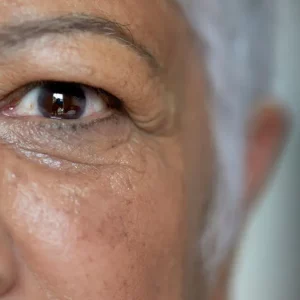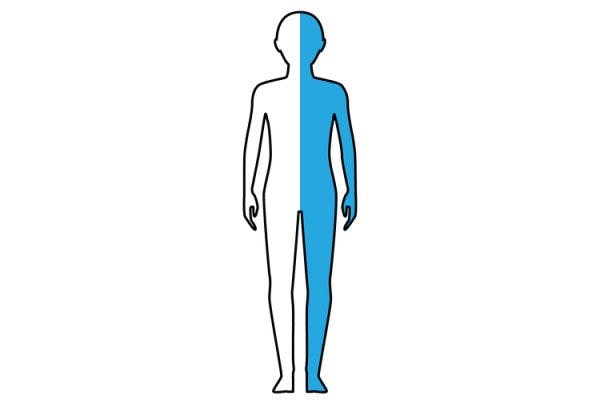Fluent aphasia is a type of cognitive communication disorder that may occur after a stroke or brain injury. Also known as receptive aphasia or Wernicke’s aphasia, fluent aphasia involves impaired language comprehension. As a result, individuals are often able to speak fluently, but their language may lack meaning and sound nonsensical.
This article provides an overview of the symptoms and characteristics of fluent aphasia, along with ways to manage the condition. Use the links below to jump straight to any section:
- What is Fluent Aphasia?
- Symptoms of Receptive Aphasia
- Diagnosing Fluent Aphasia
- Progression of Wernicke’s Aphasia
- Managing Fluent Aphasia
What is Fluent Aphasia?
Aphasia is an umbrella term describing a number of cognitive communication disorders. Individuals with aphasia may have difficulties with a number of components of language, including the ability to express oneself through spoken language, comprehend what others are saying, read, and write.
Each type of aphasia can be classified as fluent or non-fluent. Wernicke’s aphasia is the most common type of fluent aphasia. Other fluent aphasias include anomic aphasia, conduction aphasia, and transcortical sensory aphasia. Expressive aphasia (Broca’s aphasia), which is characterized by difficulties producing speech, is the most common non-fluent aphasia.
Although a number of conditions fall into the category of fluent aphasia, the term fluent aphasia is often used synonymously with Wernicke’s aphasia, also known as receptive aphasia. Therefore, throughout this article, the terms Wernicke’s aphasia, fluent aphasia, and receptive aphasia will be used interchangeably.
Wernicke’s aphasia is a type of aphasia caused by damage to Wernicke’s area of the brain. This region, typically located toward the back of the temporal lobe in the left hemisphere of the brain, is primarily involved with the understanding of spoken and written words.
Therefore, when this part of the brain sustains damage due to a neurological condition like stroke or brain injury, individuals may have difficulties with reading and understanding what others say. Furthermore, those with fluent aphasia may not be able produce comprehendible speech. Although they are able to speak fluently, they have lost the ability to connect words with their meaning.
Symptoms of Fluent Aphasia
Individuals with receptive aphasia may have difficulty with any activity that requires the comprehension of words, whether written or spoken. Although they are able to physically produce spoken and written language, they may use made-up words (neologisms) or simply not make sense. Since those with receptive aphasia speak incoherently but fluently, it may almost seem like they are speaking a different language.
Other symptoms of Wernicke’s aphasia include:
- Using normal speed, intonation, and grammar while speaking, although the words may lack meaning
- Difficulty understanding others
- Inability to repeat words or phrases
- Difficulties with reading and writing
In addition, most individuals with receptive aphasia do not realize they have any problems with speech. As a result, they might express confusion or frustration when others do not understand them.
The video below of a stroke survivor with fluent aphasia highlights how someone with fluent aphasia may speak:
Diagnosing Fluent Aphasia
If neurological damage is localized to Wernicke’s area, individuals typically do not exhibit any other cognitive or physical impairments. Because those with fluent aphasia have sustained damage to the back portion of the brain where Wernicke’s area is located, other areas such as motor cortex and frontal lobe tend not to be affected.
Therefore, unlike those with damage to other areas of the brain, individuals with fluent aphasia typically do not struggle with completing their activities of daily living independently. They often can still walk and move easily, and it is uncommon for them to be affected by other conditions such as left neglect or memory impairments.
As a result, the individual can appear unaffected and is not easily recognized as a stroke survivor. Therefore, when they speak, others often assume they have a mental health problem. They are also often mislabeled as intoxicated.
For an accurate and timely diagnosis, survivors and their family members should discuss any changes in communication with their medical team. Consulting with a speech therapist is strongly recommended to identify the type(s) of aphasia a survivor may be demonstrating and learn about recommended treatment options.
When the symptoms of fluent aphasia are recognized early in the recovery process, survivors can seek treatment sooner. Addressing fluent aphasia promptly can help survivors achieve an optimal recovery.
Progression of Wernicke’s Aphasia
Fluent aphasia may begin to fade after a certain amount of time. In fact, when fluent aphasia is caused by a stroke, the most significant progress is generally made 2-6 months following the stroke.
While everyone’s recovery from Wernicke’s aphasia is different, there is a certain progression that many survivors may follow. The list below describes the typical progression of Wernicke’s aphasia from its most severe form to mild impairment:
Stage 1: Confusion and Nonsensical Speech
In the early days, speech may sound fluent but lacks any real meaning. This is sometimes called “word salad”—a jumble of unrelated words strung together in a way that doesn’t make sense. The individual typically has minimal understanding of spoken or written language and may seem unaware that their speech isn’t coherent.
Stage 2: Decreased Confusion, Continued Word Jargon
As confusion begins to ease, speech may still be garbled or nonsensical. At this point, the person may become more frustrated—aware that communication isn’t working but unsure why. Caregivers may start to notice more attempts to express ideas, even if they aren’t yet clear.
Stage 3: Understanding in Contextual Situations
Next comes a turning point: survivors start to understand simple language in familiar or visual situations. For example, if someone points to a glass of water and asks, “Want some?”—the person may respond appropriately. These contextual cues become essential tools for communication.
Stage 4: Improved Comprehension and More Natural Speech Rhythm
At this stage, speech may start to sound more natural in terms of rhythm and tone—but it still might not make sense. However, comprehension improves, especially with slow speech and simple phrases. This is often the point where loved ones see encouraging signs of progress.
Stage 5: Increased Self-Awareness and Clearer Speech
This is a significant milestone. The person begins to realize that what they’re saying isn’t always accurate, which opens the door to more active participation in speech therapy. Their words and ideas start to become more coherent, though some errors still occur.
Stage 6: Word Repetition and Writing Support
Now, the survivor is often able to repeat spoken words and recognize simple written words. In addition, writing becomes a helpful communication tool —some survivors find it easier to communicate through notes or even text messages. These strategies help bridge communication gaps while speech continues to improve.
Stage 7: More Meaningful, Coherent Language
Speech becomes more accurate and appropriate, with real words used in the correct context. Some difficulty may remain, especially with finding the right word, but conversations become much easier to follow.
Stage 8: Transition to Mild Forms of Aphasia
Survivors may progress to very mild forms of aphasia, such as anomic aphasia. They may still struggle with finding the right words to say, but comprehension and speech coherency has greatly improved.
Each survivor progresses at their own rate and may not follow these stages precisely. However, these stages can help survivors and their families to understand what to expect while recovering from fluent aphasia.
Managing Fluent Aphasia
Receptive aphasia requires a different therapy approach than other types of aphasia. Unlike expressive aphasia (Broca’s Aphasia), which involves difficulties with producing language, fluent aphasia involves trouble with phonological processing (understanding both written and spoken language-related sounds).
This means not only do those with fluent aphasia have trouble understanding others, but they also may not realize when the sounds they are using to speak are inaccurate. Therefore, fluent aphasia treatment focuses primarily on learning to connect words with their meanings again.
There are a number of treatment options for fluent aphasia. Speech therapists specialize in the area of communication disorders and can be instrumental in helping individuals with fluent aphasia learn to communicate more effectively.
Here are some treatment techniques that may be used to address fluent aphasia:
Context-based Therapy
This treatment technique focuses on improving comprehension through conversation. Speech therapists speak clearly, stressing important points through redundancy and non-verbal communication while the individual listens, taking an active role in their treatment by paraphrasing what has been said and asking for repetition as needed.
Comprehension Exercises
Speech therapists may use a number of exercises focused on improving comprehension, gradually increasing the difficulty level as indicated. Exercises may include following simple directions, such as “point to your nose”, or matching pictures with words.
Compensation Techniques
Although relearning to grasp the meaning behind words is ideal, individuals may be encouraged to utilize compensation techniques to make up for their communication challenges. A common compensation technique is using non-verbal communication strategies, such as drawing a picture or gesturing.
Family Training
Family members and caregivers can be a vital part of recovery. Speech therapists may provide family members with recommendations on how to promote effective communication, such as speaking slowly, clearly, and respectfully and discussing situationally-relevant information.
Non-invasive Brain Stimulation
Using transcranial direct-current stimulation and other non-invasive brain stimulation methods can promote neurological recovery, allowing individuals to regain communication skills. Although there are a number of studies on this treatment, it is still relatively new and is most effective when combined with other more conventional treatment methods.
Home Programs
Continuing to practice receptive communication skills outside of therapy can boost recovery. This is because repetitive practice activates neuroplasticity, the brain’s ability to rewire itself. While many speech therapists provide a list of exercises to practice at home, speech therapy apps, such as the CT Speech and Cognitive Therapy App, can be tailored to an individual’s skill level to help them continue progressing toward recovery.
While there are many treatment options, working closely with a speech therapist can allow individuals to create a personalized recovery program. Pursuing rehabilitation, especially early in recovery, can help promote an optimal recovery.
Understanding Fluent Aphasia
Damage to Wernicke’s area can cause an individual to lose their ability to understand language. They also will struggle to produce meaningful words and phrases, speaking fluently but incoherently.
This is often frustrating for the individual, as they usually do not understand why others are confused by their words. Fortunately, this type of aphasia usually fades as the brain heals. Working with a speech therapist can help individuals improve their language comprehension skills and recover their ability to communicate effectively.
Still have questions? Check out our recent article to learn the difference between expressive (Broca’s Aphasia) vs receptive aphasia (Wernicke’s Aphasia).










